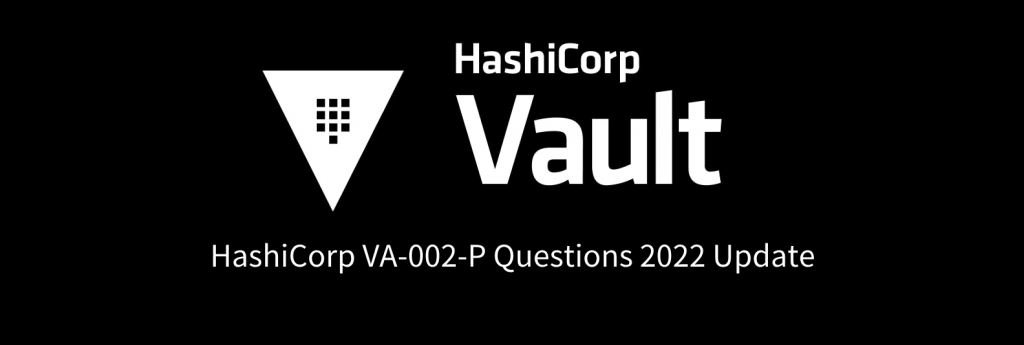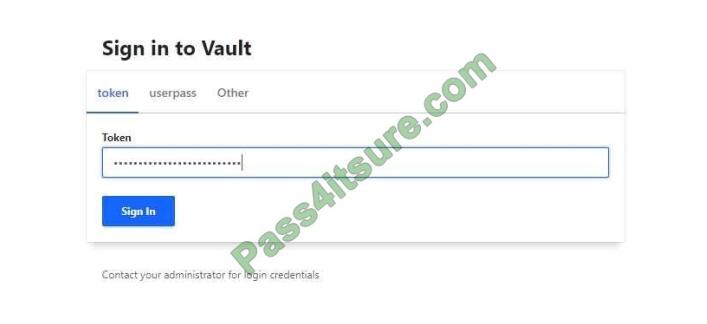
Online HashiCorp VA-002-P exam questions are available for you to study. Careful study of the following HashiCorp VA-002-P exam questions will help you pass the exam.
How to avoid failing the nightmare HashiCorp VA-002-P exam?
Spent a lot of money and effort, and still haven’t passed the HashiCorp Certified: Vault Associate exam? What’s going on? I’ll tell you, do the right thing in the right way. Your approach is wrong. Successful passing of the HashiCorp VA-002-P exam requires correct preparation for the exam using an accurate syllabus.
Learn and prepare VA-002-P exam dumps with actual questions https://www.pass4itsure.com/va-002-p.html (Q&As: 200).
Where can I get the full HashiCorp VA-002-P exam questions?
Here we will share some of your hashiCorp VA-002-P exam questions q1-q12 for free. More to buy – Pass4itSure hashiCorp VA-002-P exam dumps designed for VA-002-P exams: with highly authentic and up-to-date VA-002-P exam study materials, both PDF and VCE.
Trusted and latest preparation HashiCorp VA-002-P pdf download:
free HashiCorp VA-002-P pdf https://drive.google.com/file/d/1Nuis-KY8M8B9KVfsea4byAlbVduwac_v/view?usp=sharing
VA-002-P dumps [2022] 100% accurate VA-002-P exam questions:
VA-002-P Q&As
Q #1
True or False: When encrypting data with the transit secrets engine, Vault always stores the ciphertext in a dedicated
KV store along with the associated encryption key.
A. False
B. True
Correct Answer: A
Vault doesn\’t store the data sent to the secrets engine. The transit secrets engine handles cryptographic functions on
data-in-transit. It can also be viewed as “cryptography as a service” or “encryption as a service”. The transit secrets
engine can also sign and verify data; generate hashes and HMACs of data; and act as a source of random bytes.
Reference link:- https://www.vaultproject.io/docs/secrets/transit
Q #2
The Vault Agent provides which of the following benefits? (select three)
A. client-side caching of responses
B. automatically creates secrets in the desired storage backend
C. authentication to Vault
D. token renewal
Correct Answer: ACD
Vault Agent is a client daemon that provides the following features:
-Auto-Auth
-Caching
-Templating
Reference link:- https://www.vaultproject.io/docs/agent
Q #3
Vault does not trust the storage backend.
A. False
B. True
Correct Answer: B
Storage backends are not trusted by Vault and are only expected to render durability. The storage backend
is configured when starting the Vault server.
Reference link:- https://www.vaultproject.io/docs/internals/architecture
Q #4
You are deploying Vault in a local data center, but want to be sure you have a secondary cluster in the event the
primary cluster goes offline. In the secondary data center, you have applications that are running, as they are
architected to run active/active. Which type of replication would be best in this scenario?
A. disaster recovery replication
B. single-node replication
C. performance replication
D. end-to-end replication
Correct Answer: C
In this scenario, the key to answering is that there are applications actively running the secondary data center. Because
of this, you can deploy Performance Replication and the applications can now use the Vault cluster in their respective
data center. This reduces network latency for your applications and provides you with a secondary cluster for
redundancy.
Q #5
Which of the following is considered a Terraform plugin?
A. Terraform logic
B. Terraform language
C. Terraform tooling
D. Terraform provider
Correct Answer: D
Terraform is built on a plugin-based architecture. All providers and provisioners that are used in Terraform
configurations are plugins, even the core types such as AWS and Heroku. Users of Terraform are able to write new
plugins in order to support new functionality in Terraform.
Q #6
What is the result of the following Vault command?
vault auth enable userpass
A. Imports usernames and passwords from LDAP to the local database
B. allows Vault to access usernames and passwords stored in a second Vault cluster
C. Enables Vault to use external services to authenticate clients to Vault
D. mounts the user pass auth method to the default path
Correct Answer: D
The auth enable command enables an auth method at a given path. If an auth method already exists at the
given path, an error is returned.
Command to enable auth method vault auth followed by the name of the auth method.
Additional parameters can be included to specify the name of the mount.
Q #7
By default, where does Terraform store its state file?
A. shared directory
B. current working directory
C. Amazon S3 bucket D. remotely using Terraform Cloud
Correct Answer: B
By default, the state file is stored in a local file named “terraform. state”, but it can also be stored remotely, which works
better in a team environment.
Q #8
Why might a user opt to include the following snippet in their configuration file?
1. terraform {
2.required_version = “>= 0.12”
3.}
A. this ensures that all Terraform providers are above a certain version to match the application being deployed
B. the user wants to ensure that the application being deployed is a minimum version of 0.12
C. versions before Terraform 0.12 were not approved by HashiCorp to be used in the production
D. Terraform 0.12 introduced substantial changes to the syntax used to write Terraform configuration
Correct Answer: D
You can use required_version to ensure that a user deploying infrastructure is using Terraform 0.12 or greater, due to
the vast number of changes that were introduced. As a result, many previously written configurations had to be
converted or rewritten.
Q #9
When using constraint expressions to signify a version of a provider, which of the following are valid provider versions
that satisfy the expression found in the following code snippet: (select two)
1.terraform {
2.required_providers {
3.aws = “~> 1.2.0”
4.}
5.}
A. 1.2.9
B. 1.3.1
C. 1.3.0
D. 1.2.3
Correct Answer: AD
~> 1.2.0 will match any non-beta version of the provider between >= 1.2.0 and
Q #10
When administering Vault on a day-to-day basis, why is logging in with the root token, as shown below, a bad idea?
(select two)

A. the root token isn\’t a secure way of logging into Vault
B. the root token is attached to the root policy, which likely provides too many privileges to a user
C. the root token should be revoked and not used on a day-to-day basis
D. It\’s easier to just use the root token than to configure additional auth methods
Correct Answer: BC
The root token should never be used on a day-to-day basis and should always be revoked once a permanent auth
the method has been configured.
Q #11
You\’ve set up multiple Vault clusters, one on-premises which is intended to be the primary cluster, and the second
cluster in AWS, which was deployed to be used for performance replication. After enabling replication, developers
complain that all the data they\’ve stored in the AWS Vault cluster is missing. What happened?
A. the data was moved to a recovery path after replication was enabled. Use the vault secrets move command to move
the data back to its intended location
B. there is a certificate mismatch after replication was enabled since Vault replication generates its own TLS certificates
to ensure nodes are trusted entities
C. the data was automatically copied to the primary cluster after replication was enabled since all writes are always
forwarded to the primary cluster
D. all of the data on the secondary cluster was deleted after replication was enabled
Correct Answer: D
Replication relies on having a shared keyring between primary and secondaries and a shared
understanding of the data store state.
As soon as replication is enabled, all of the secondary\’s existing data will be destroyed, which is
irrevocable.
Generally, activating as a secondary will be the first thing that is done upon setting up a new cluster for
replication.
Hence, create a backup first if there is a slight chance that you would need this existing storage in the
future.
Reference link:- https://www.hashicorp.com/resources/setting-up-configuring-performance- replication/
Q #12
True or False:
Multiple providers can be declared within a single Terraform configuration file.
A. False
B. True
Correct Answer: B
Multiple provider blocks can exist if a Terraform configuration is composed of multiple providers, which is a common
situation. To add multiple providers in your configuration, declare the providers, and create resources associated with
those providers.
What I would recommend to anyone who wants to earn this certificate is familiar with the HashiCorp VA-002-P exam questions. Make sure you know HashiCorp Certified: Vault Associate inside out. Practice as much as possible with the HashiCorp VA-002-P practice test.
The Pass4itSure HashiCorp VA-002-P dumps question you really need helps you pass the exam 100% https://www.pass4itsure.com/va-002-p.html (latest).
Follow the links below for other exam practice questions in the HashiCorp series: https://www.actual4tests.com/category/hashicorp/